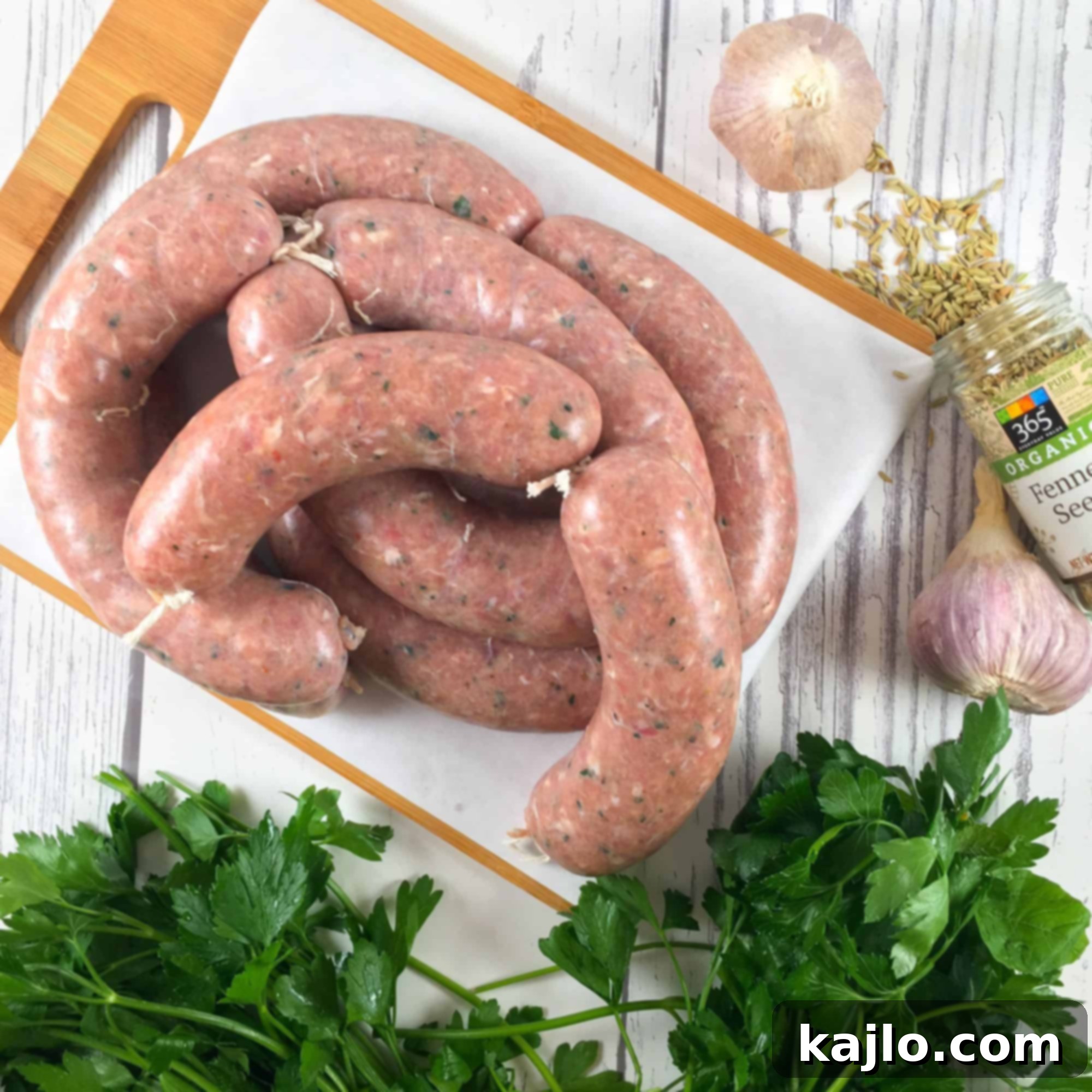Embark on a culinary adventure this weekend and discover the unparalleled satisfaction of crafting your own **homemade Italian fennel sausage**. With just a meat grinder and a touch of patience, you can create a batch of the absolute **BEST fennel sausage** you’ve ever tasted. Our unique recipe blends succulent pork with lean chicken, offering a lighter option that’s incredibly flavorful and cooks beautifully without needing extra oil. This isn’t just a recipe; it’s an invitation to experience the art of artisanal sausage making, transforming simple ingredients into a gourmet delight. Imagine the rich, aromatic flavors filling your kitchen as you prepare these exquisite links. Once you try this **Italian fennel sausage recipe** using a meat grinder, you’ll understand why homemade is always superior. Don’t let your weekend go by without trying this rewarding and delicious project!
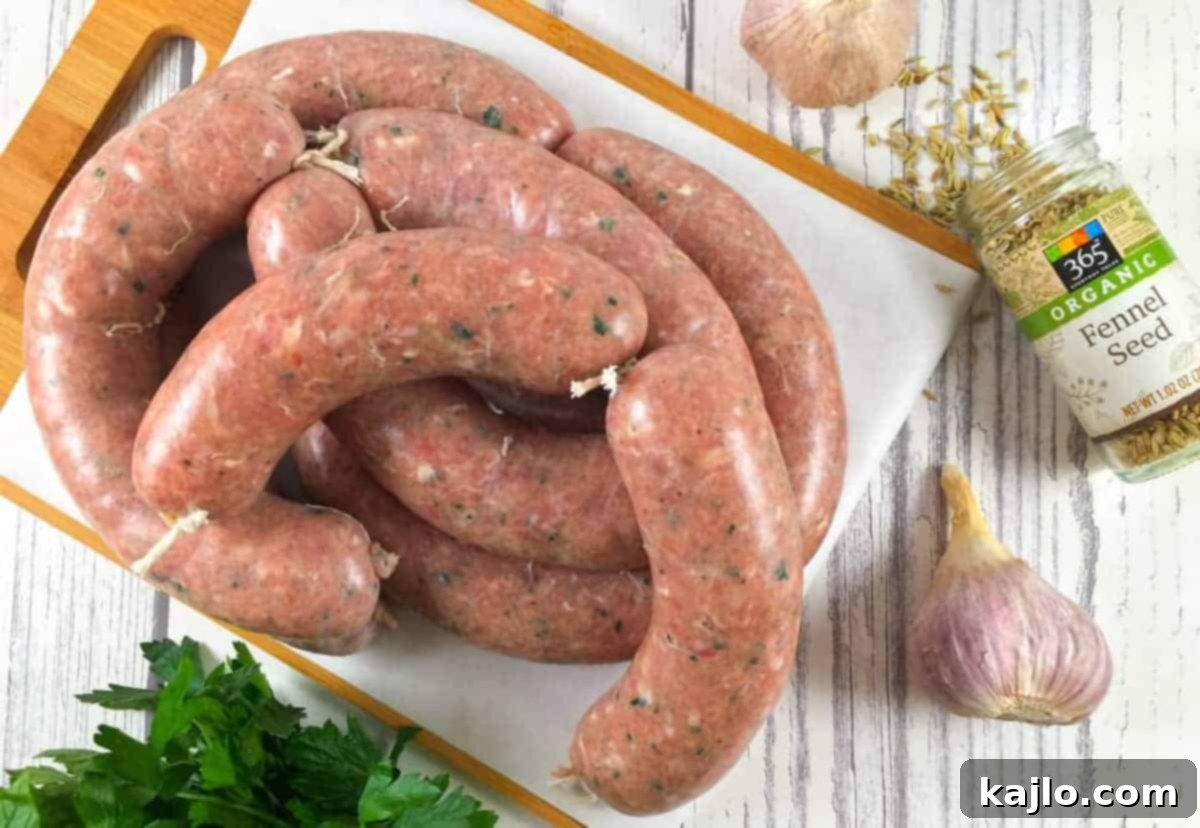
If you own a meat grinder and are eager to expand your culinary skills, this **homemade Italian sausage recipe** is an absolute game-changer. The versatility of these sausages knows no bounds – from hearty pasta dishes to savory breakfast scrambles, the possibilities are endless. Dedicate a small amount of time to this fulfilling process, and you’ll reap the rewards of delicious, wholesome homemade fennel sausage for weeks to come, ready to enjoy even when your schedule gets hectic. This recipe isn’t just about making food; it’s about reclaiming control over your ingredients and savoring the true taste of fresh, custom-made fare.
💰 **The Value Proposition: Cost and Time in Homemade Sausage Making**
When considering any “slow food” endeavor, such as making your own sausages, the primary factors are monetary cost and time investment. While there’s an initial time commitment, the long-term savings and superior quality often make it a worthwhile pursuit. Ultimately, embracing homemade options can lead to significant savings on your grocery bill.
In today’s market, pork prices can fluctuate. Our recipe wisely incorporates a blend of half pork and half chicken. This not only results in a lighter, leaner sausage but also presents a smart strategy to manage costs without sacrificing flavor. By balancing the meat types, you achieve a delightful taste while potentially saving money.
The most significant upfront expense for aspiring sausage makers, if you don’t already possess one, is the meat grinder itself. However, for those not ready for this investment, a valuable shortcut exists: simply season store-bought ground meat with our specialized sausage seasonings. This approach, which we’ve explored in recipes like our air fryer pork sausage, still delivers fantastic flavor with less equipment.
Yet, the advantages of owning a meat grinder are considerable. It empowers you to utilize diverse cuts of meat and poultry that aren’t typically available pre-ground. Furthermore, if your grinder is equipped with a sausage stuffer attachment, you gain the ability to create authentic sausage links encased in natural casings, elevating your homemade creations to a professional level.
The journey from whole cuts of fresh meat to perfectly formed sausage links can be distilled into three fundamental steps:
- **Prepare the Seasoned Meat Mixture:** This involves dicing your chosen meats and thoroughly blending them with our carefully selected herbs and spices.
- **Grind the Meat:** Pass the seasoned meat through your meat grinder, typically in two stages for optimal texture.
- **Stuff into Casings:** For those desiring traditional links, this final step involves feeding the forcemeat (the ground meat mixture) into natural sausage casings using a stuffer attachment.
While the steps are straightforward, even the most efficient sausage maker will need a few dedicated hours to produce a substantial freezer-full of delicious homemade Italian fennel sausage. It’s important to acknowledge this time commitment before you begin. We highly recommend allocating a relaxed block of time, perhaps a weekend afternoon or a non-work day, ensuring you feel unhurried and can truly enjoy the process. This approach allows for a stress-free, engaging culinary experience.
The enjoyment of slow food preparation truly flourishes when the atmosphere is relaxed and unpressured. Avoid letting this creative endeavor become another chore on your overflowing to-do list. Embrace the craft, have fun, and savor every moment of bringing these incredible homemade fennel sausages to life!
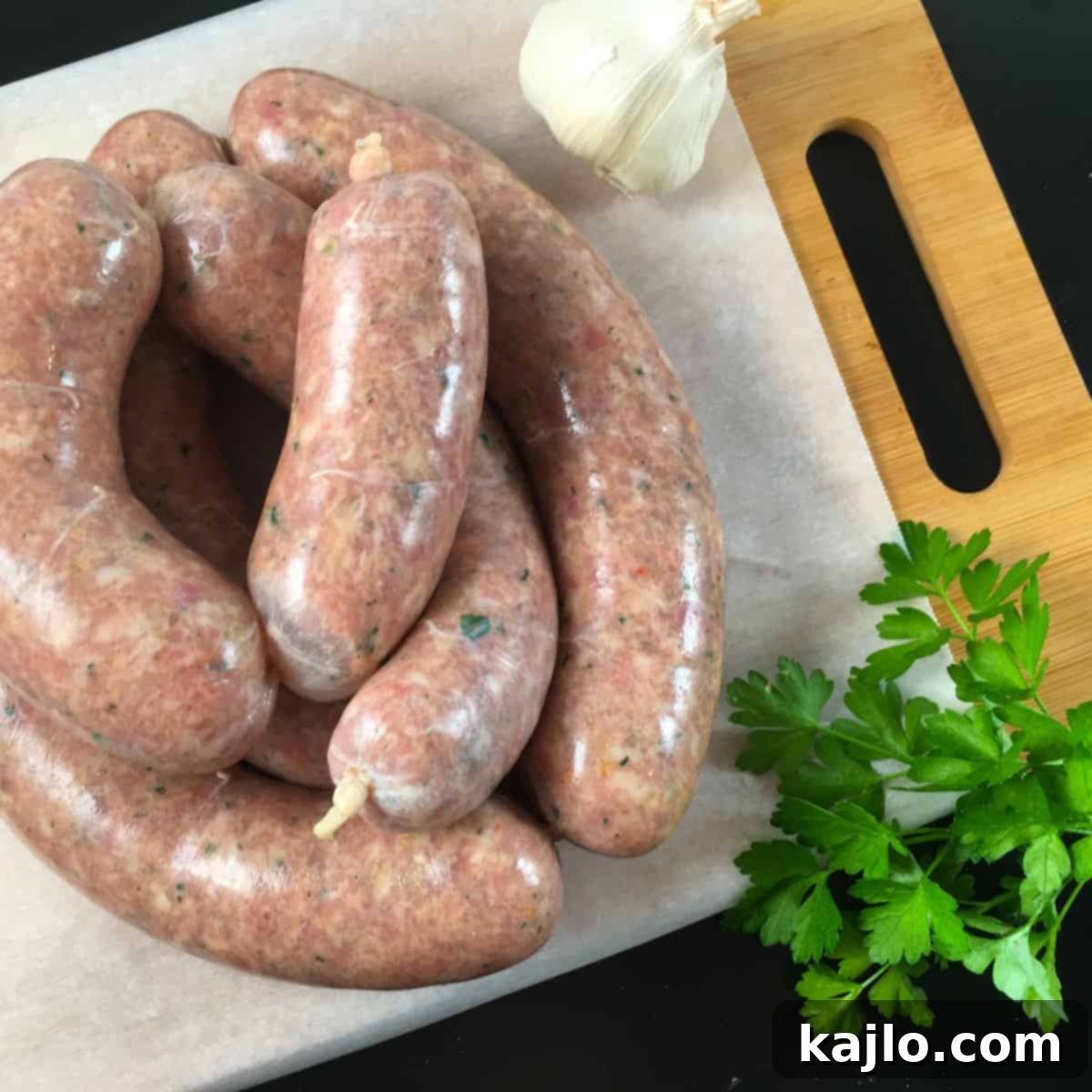
**🌭 Fennel Sausage vs. Italian Sausage: A Clarification**
**What defines fennel sausage?** Simply put, fennel sausages are a specific type of sausage characterized by the inclusion of fennel seeds in their seasoning blend. In the United States, the term “Italian sausage” commonly implies the presence of fennel seed. However, it’s worth noting that authentic Italian sausages, originating directly from Italy, exhibit a much broader range of regional variations and may or may not contain fennel seed. This recipe celebrates the delightful, distinctive flavor that fennel brings to Italian-style sausage.
**⭐ Why Choose Homemade Fennel Sausage? Unveiling the Benefits**
Beyond the undeniable deliciousness, there are numerous compelling reasons to embrace this **garlic fennel sausage recipe**. We’ve already touched upon the potential cost savings, but the benefits extend significantly into the realm of nutrition and dietary compatibility. Here’s a closer look at what makes this homemade sausage an exceptional choice:
- **Keto and Low Carb Friendly:** Each serving of this carefully crafted sausage contains less than 1 gram of net carbohydrates, making it an excellent fit for ketogenic and low-carb dietary approaches. The unique combination of pork and chicken, without any additional fats, results in a high-protein, lower-fat sausage option. For those managing their weight with a very low-carb diet, this recipe offers a delicious, lower-calorie sausage that perfectly aligns with your goals. It allows you to enjoy rich flavors without compromising your macro targets.
- **Allergen-Friendly and Dietary Versatility:** This homemade fennel sausage is naturally gluten-free, dairy-free, and soy-free, making it suitable for a wide array of special diets. Whether you’re following a Paleo, Whole30, or a general clean-eating plan, this recipe seamlessly integrates into your lifestyle. It’s a truly inclusive option, allowing more people to enjoy the savory taste of Italian sausage without dietary concerns.
- **Packed with Essential Nutrients:** Both pork and chicken are powerhouse sources of vital B-complex vitamins, crucial for energy metabolism and nervous system health. They also provide high-quality protein, essential for muscle repair and growth. While grains offer some B vitamins, meat provides unique forms of certain B vitamins, notably B12, which is exclusively found in animal products, along with highly bioavailable minerals that are easily absorbed by the body.
- **Minimally Processed, Wholesome Food:** Commercial sausages are often categorized among ultra-processed foods, which many health guidelines recommend limiting. In stark contrast, these raw, homemade sausages, prepared with fresh ground meat and natural seasonings, are considered minimally processed. You maintain complete control over every ingredient, ensuring a clean, wholesome product that doesn’t contribute to the intake of artificial additives or excessive sodium often found in store-bought alternatives.
- **Incredibly Delicious and Versatile:** Beyond its nutritional merits, this meat grinder fennel sausage boasts an exceptional flavor profile that most will find utterly delightful. (And, in my humble opinion, any nourishing food worth discussing should be incredibly tasty!) Its robust flavor and satisfying texture make it a fantastic way to enhance a myriad of meals, adding both a protein boost and an explosion of savory-sweet notes. Use it in pasta sauces, hearty stews, breakfast hashes, or as a gourmet pizza topping.
**🥘 Essential Ingredients for Your Homemade Fennel Sausage**
**What are the core components of fennel sausage?** Italian sausage recipes can vary significantly, with each cook often having their preferred blend. Our recipe, however, focuses on a harmonious combination of quality meats and a balanced array of fresh and dried seasonings. Here’s a detailed list of what you’ll need to create this exceptional sausage:
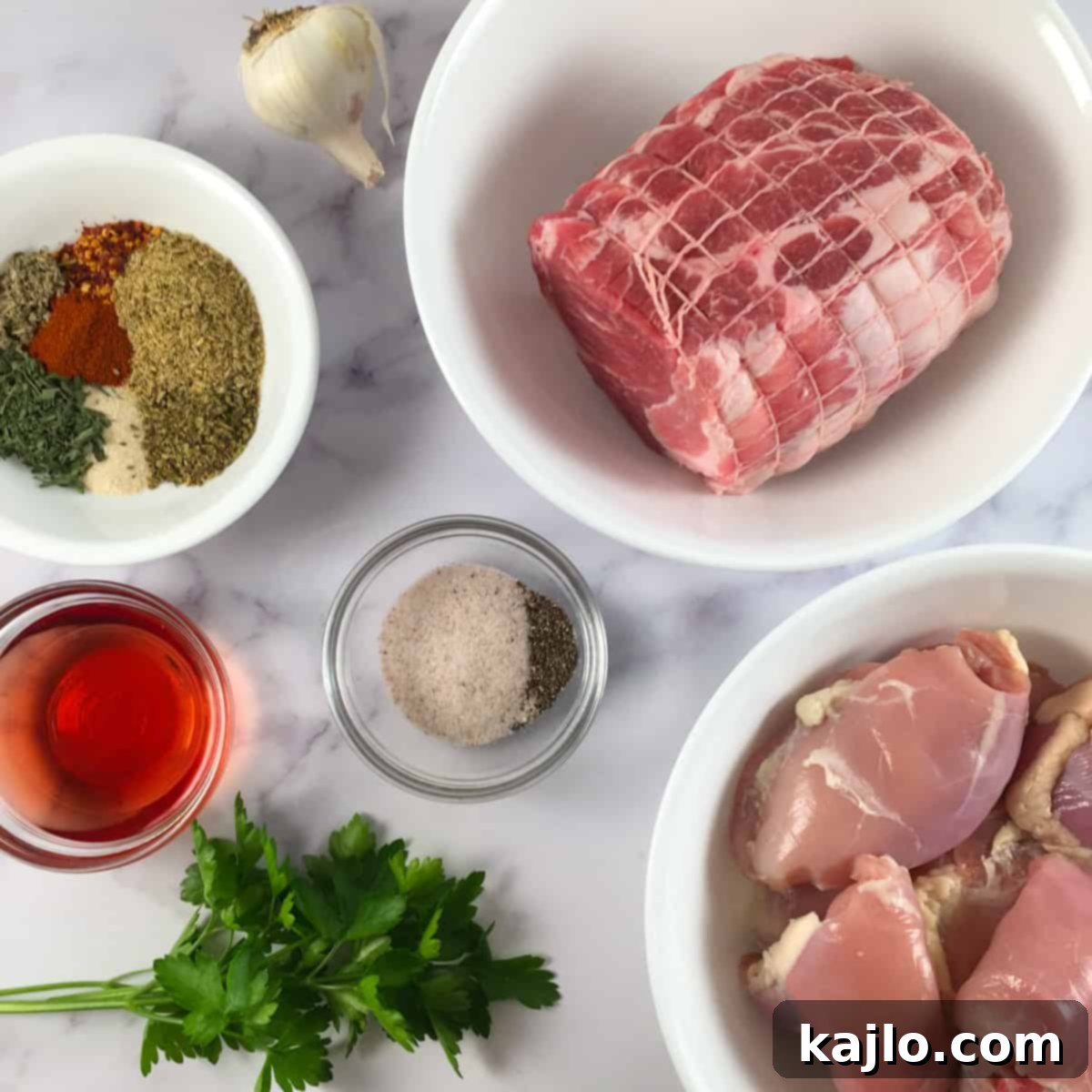
- **Pork Shoulder or Boston Butt (Pork Butt):** This cut is essential for its rich flavor and ideal fat content. Pork shoulder provides the necessary moisture and mouthfeel that makes a great sausage without being overly greasy.
- **Boneless, Skinless Chicken Thighs:** Incorporating chicken thighs not only makes the sausage leaner and contributes to cost savings but also adds a delicate texture and balances the richness of the pork.
- **Red Wine Vinegar:** A splash of red wine vinegar brightens the flavor profile, adds a subtle tang, and helps to tenderize the meat, contributing to the overall complexity of the sausage.
- **Aromatic Fresh and Dried Herbs & Spices:** This is where the magic happens! We’ll delve into the specific blend in the next section, but expect a vibrant mix that delivers the classic Italian fennel sausage taste.
- **Hog Casings:** For authentic links, natural hog casings are key. They provide the traditional shape and texture, allowing the sausage to cook evenly and hold its form.
One notable omission from this list, which you might find in many traditional Italian sausage recipes, is added fat. While many recipes call for additional pork belly, fatback, or bacon, we’ve found that the inherent fattiness of the pork shoulder, combined with the chicken thighs, provides ample moisture and flavor. This means you can enjoy a delicious sausage without the need for extra rendered fat during cooking.
Choosing the right sausage casing is vital for successful homemade links. If you have a preferred brand that pairs well with your specific sausage funnels, feel free to use it. Personally, I rely on these natural hog casings. They are perfectly suited for use with my largest sausage funnel, yielding substantial Italian sausage links that are robust and satisfying.
Initially, these casings might appear too small for large sausages, but through extensive trial-and-error with various funnel sizes, I’ve discovered they are indeed ideal for crafting generous links. This size, in my opinion, is just right for showcasing the rich flavors of fennel sausage, providing a hearty portion that cooks beautifully.
Beyond their perfect size, these casings offer several practical benefits: they are notably durable and resistant to tearing, which simplifies the stuffing process. Furthermore, their excellent storage qualities are a huge plus. When packed in a container of salt and refrigerated, they remain fresh and ready for your next sausage-making adventure whenever inspiration strikes. This ensures you always have quality casings on hand for impromptu culinary projects.
🧂️ **Mastering the Flavor: How to Season Italian Sausage**
The heart of any exceptional Italian sausage lies in its seasoning. While every culinary enthusiast has their unique take on the perfect blend, our recipe focuses on a harmonious combination of herbs and spices that delivers that quintessential, mouthwatering Italian flavor. Here’s the specific blend we recommend for seasoning your homemade Italian sausage:
- **Ground Fennel Seeds:** The star of the show, providing the characteristic anise-like flavor that defines Italian fennel sausage. Grinding them freshly enhances their aromatic impact.
- **Fresh Parsley:** Adds a vibrant, herbaceous note and a touch of freshness that brightens the overall profile of the sausage.
- **Fresh Garlic:** Essential for its pungent, savory depth, fresh garlic is a cornerstone of Italian cuisine and contributes significantly to the sausage’s robust flavor.
- **Onion Powder:** Provides a concentrated, sweet onion flavor that complements the garlic and other spices, adding layers of savory complexity.
- **Dried Basil:** A classic Italian herb that imparts a sweet, peppery, and slightly minty undertone, enhancing the authentic taste.
- **Dried Oregano:** Offers a robust, earthy, and somewhat bitter note, balancing the sweeter elements and providing a foundational Italian flavor.
- **Crushed Red Pepper Flakes:** For a hint of warmth and a gentle kick, these flakes add a subtle spice that awakens the palate without overwhelming the other flavors.
- **Dried Sage:** Introduces an earthy, slightly peppery, and savory aroma, pairing beautifully with pork and adding an autumnal depth.
- **Sweet Paprika:** Contributes a mild, sweet, and fruity flavor along with a beautiful reddish hue, enhancing both taste and appearance.
- **Salt and Black Pepper:** Fundamental seasonings that amplify all the other flavors, balancing the blend and providing essential taste.
Feel free to experiment with these proportions and even swap fresh herbs for dried, or vice versa, to suit your personal taste preferences. For instance, consider using fresh sage to impart a brighter, more herbal note than its dried counterpart. A general rule of thumb for substitutions is to use approximately 1 tablespoon of fresh herbs for every teaspoon of dried herbs to achieve a comparable flavor intensity.
Regarding salt, I typically opt for finely ground sea salt for its clean taste. However, you can certainly use 1 tablespoon of Morton kosher salt or, for a less dense crystal, 2 tablespoons of Diamond Crystal salt if those are your preferred choices. Always adjust salt to your palate, keeping in mind the other flavorful components.
**🍽 Essential Equipment for Homemade Sausage Making**
The cornerstone of successful homemade sausage production is a high-quality meat grinder. For this recipe, and indeed for all my sausage-making endeavors, I confidently use the Cabela’s Pro Series DC meat grinder. I genuinely believe it stands out as the **best meat grinder** available within its price range, offering exceptional performance and value.
This particular model comes equipped with both a coarse and a fine grinding plate, along with a selection of multiple sausage funnels, providing versatility for various sausage types. It excels at grinding meat quickly and efficiently, is remarkably easy to clean, boasts a sturdy construction, and is incredibly user-friendly. Having owned it for over a year, I can honestly say I have encountered no complaints; it’s a reliable workhorse in my kitchen.
In addition to the meat grinder, a few other tools will streamline your sausage-making process. I find large, robust kitchen shears invaluable for efficiently cutting the pork and chicken into uniform pieces. If you’re skilled with a meat cleaver and a sharp chef’s knife, those are excellent alternatives for meat preparation. For grinding whole fennel seeds, if they aren’t pre-ground, a mortar and pestle is ideal for achieving the perfect consistency and releasing their aromatic oils.
For forming your sausage links, kitchen twine is necessary if you prefer to tie them off for distinct segments. Alternatively, a simpler method involves tying knots directly into the casing, or twisting the links manually. However, tying offers a more secure and traditional presentation.
Given that this recipe yields a generous amount of sausage, proper storage for freezing is crucial. My preferred method is using a vacuum sealer with food-safe vacuum sealer bags, as this preserves freshness and prevents freezer burn most effectively. As an alternative, you can certainly use standard plastic freezer bags, ensuring the sausages are tightly wrapped with additional plastic wrap to minimize air exposure and maintain quality.
**🔪 Crafting Your Own: How to Make Italian Fennel Sausage**

Let’s begin the exciting process of learning **how to make Italian fennel sausages**! Start by meticulously prepping all your ingredients. If your fennel seeds are whole, crush them thoroughly using a mortar and pestle or a spice grinder to release their full aroma. Next, it’s crucial to cut both the pork and chicken into small, uniform cubes, ideally 1-inch (2.54-cm) or even smaller. This step, while potentially the most time-consuming, is vital. Properly sized meat pieces ensure a smooth grinding process, preventing jams and strain on your meat grinder. Precision here saves effort later.
Once your meat is perfectly diced, combine it with the red wine vinegar and all the prepared seasonings in a large mixing bowl. Use your hands to thoroughly mix the ingredients, ensuring that every piece of meat is evenly coated with the aromatic spice blend. This meticulous mixing is key to a flavorful sausage. After combining, place the entire mixture back into the refrigerator. For optimal grinding and to maintain food safety, it’s best to keep the meat mixture very cold, ideally between 38-40 degrees Fahrenheit (3.3-4.4°C), almost to the point of being slightly frozen. This firm texture allows the grinder to process the meat cleanly and efficiently.
Now, it’s time to assemble your meat grinder. Attach the coarse grinding plate to your machine. Ensure all parts are securely in place and that the grinder is stable on your work surface. Begin to feed all of the chilled, seasoned chicken and pork mixture through the grinder. Work steadily but avoid forcing the meat, allowing the machine to do its job. The coarse grind will create a good base texture for your sausage, ensuring it’s not overly smooth and retains a pleasant chewiness.
For an optimal texture and to ensure all seasonings are thoroughly incorporated, pass the ground fennel sausage mixture through the grinder a second time, still using the coarse grinding plate. This double grind helps to create a more cohesive and evenly textured forcemeat, which is essential for both patties and links.
At this stage, your beautifully seasoned ground sausage mixture is ready. If you prefer, you can easily shape it into convenient patties for immediate cooking or freezing. However, if your goal is to create traditional sausage links, place the ground meat back into the refrigerator while you quickly clean and reconfigure your meat grinder for the sausage stuffing process. Keeping the meat cold is crucial for successful stuffing and prevents it from becoming too soft to handle.
**👨🍳 Mastering Sausage Links: How to Stuff Sausage with a Grinder**
After grinding, thoroughly clean your meat grinder to remove any residual meat and prepare it for the stuffing phase. Attach the largest stuffing funnel – this is generally ideal for hog casings. To make the casing slide on effortlessly, lightly rub the exterior of the stuffing funnel with a small amount of olive oil. This lubrication significantly eases the process and prevents tearing.
Begin by carefully removing your hog casings from their packaging. Rinse them thoroughly under cool, running water to remove any excess salt. Then, follow the specific preparation instructions provided on your casing’s packaging. Typically, this involves soaking them in cool water for about 15 minutes to rehydrate them, followed by gently untangling and cutting them into manageable 2-foot (0.6 m) lengths. Open one end of each casing and allow cool tap water to flow through its entire length. Repeat this rinsing process three times for each casing you plan to use, ensuring only the insides of the casings are rinsed. After rinsing, tie a secure knot in one end of each prepared casing and place them on a paper towel near your grinder, ready for stuffing.
To stuff your fennel sausages, carefully slide a prepared casing over the end of the stuffing funnel. A helpful technique is to gather the casing much like you would pantyhose before putting them on, then gently ease it onto the funnel. My grinder recommends leaving approximately 2 inches (5 cm) of casing overhanging the end of the funnel; however, always refer to your specific grinder’s instructions as they may vary. This overhang is crucial for securely tying off the first link.
With your casing in place, very slowly begin feeding the ground sausage mixture through the meat grinder, ensuring you use the designated sausage stuffing setting. This process requires a coordinated effort: one hand will operate the stomper to gently push the meat mixture into the grinder, while your other hand skillfully guides the casing as it fills. Maintain a steady, even pressure to prevent air pockets and avoid overfilling, which can lead to breakage.
Once you’ve filled one entire casing, carefully remove it, slide a new casing onto the machine, and continue the filling process. To maximize efficiency and minimize cleanup, I recommend continuing to fill all your casings before thoroughly cleaning the machine. This continuous flow helps to prevent meat from drying out in the grinder and keeps the process moving smoothly.
**❌ A Critical Mistake to Avoid During Sausage Stuffing**
During the sausage stuffing process, it is absolutely paramount to maintain constant control over the fennel sausage links with your hands! Releasing your grip, even for a moment, can lead to the casing breaking or overfilling in one section. Making consistent, perfectly filled sausage links truly requires both hands. One hand actively manages the tamper, pushing more ground meat into the machine’s feeder. Simultaneously, your other hand is dedicated to gently guiding the casing as it fills, ensuring an even distribution and preventing air bubbles or excessive tension. If you find yourself needing an extra hand, don’t hesitate to enlist a helper; two sets of hands can make this intricate step much smoother and more successful!
**😢 Troubleshooting: What to Do if Your Casings Break**
It’s not uncommon for casings to occasionally break during the sausage-making process, especially for beginners. While it can be a minor inconvenience, it’s an easily rectifiable issue. Here’s a straightforward approach to fix it: First, carefully cut open the broken section of the casing, remove the sausage filling, and discard the compromised casing. Second, take the salvaged sausage filling and feed it back into your meat grinder to be restuffed into a fresh casing.
This simple repair method resolves the problem efficiently. However, repeated casing breakage can be wasteful and frustrating. To minimize this, always ensure your meat mixture is consistently cold, avoid overfilling the casings, and maintain a steady, gentle pressure when guiding the casing off the stuffing funnel. Practice makes perfect, and with each batch, you’ll gain more confidence and skill in preventing these small setbacks.
**🥨 Tying Perfect Sausage Links: Tips and Tricks**
After successfully filling a casing, the next step is to form individual links. You can achieve this by tying off the casing at regular intervals with kitchen twine. Begin tying at the closed end of the casing, carefully leaving enough slack for the filling to expand slightly towards the open end. This crucial allowance prevents the casing from bursting as you tie, ensuring each link is firm but not overly taut. Secure the knot at the open end of the casing last, completing your string of homemade sausages.
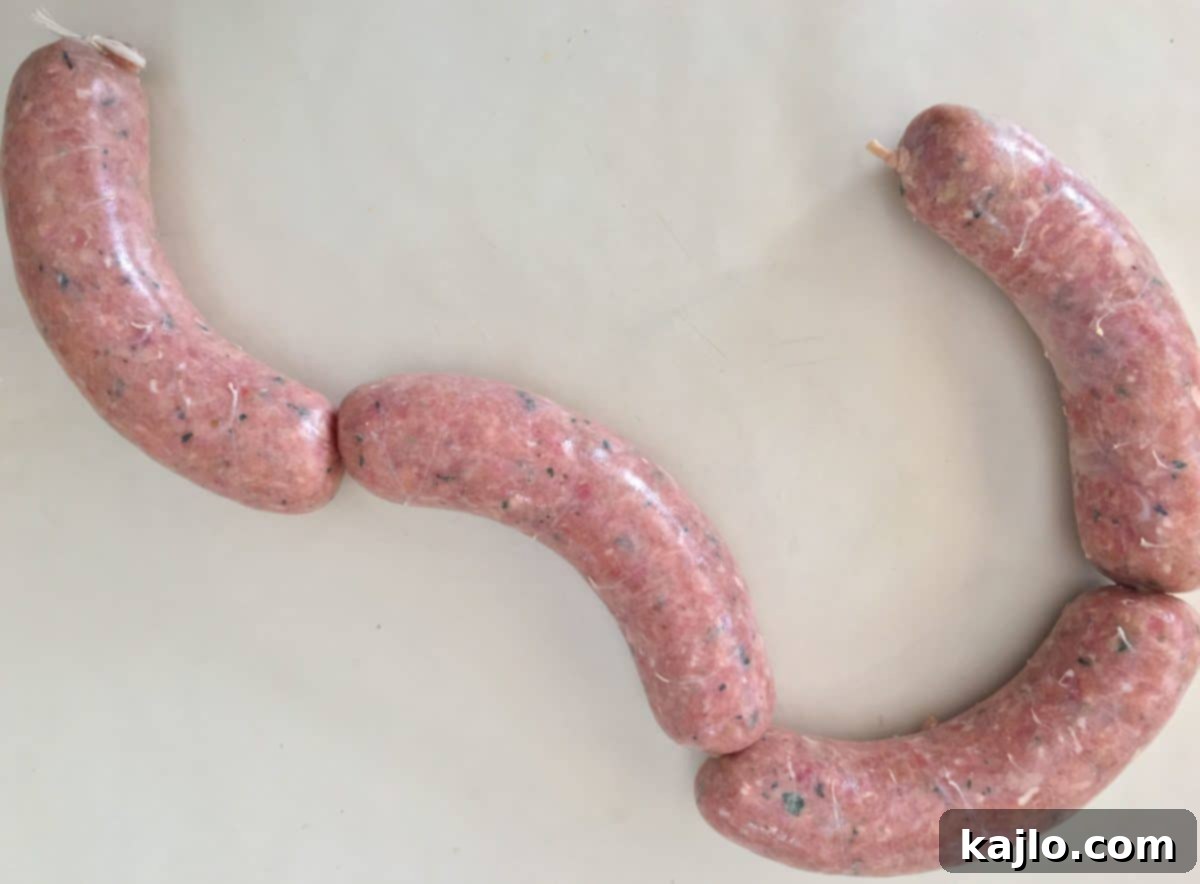
As an alternative to using twine, you can simply pinch and twist the filled casing between each desired link. If your hog casings have sufficient slack and elasticity, you might even be able to twist and then tie them for added security. However, exercise caution: if there isn’t enough room for the filling to shift within the casing, attempting to twist without adequate slack can increase the risk of the casing breaking. Always prioritize a gentle touch and proper filling to ensure beautiful, intact links.
**️⏲ Perfecting the Cook: Fennel Sausage Cooking Time and Temperature**
Once your homemade Italian fennel sausages are ready, knowing how to cook them to perfection is key. **Italian fennel sausage patties** are wonderfully versatile and can be pan-fried for several minutes on each side until golden brown and cooked through. For **homemade Italian fennel sausage links**, a fantastic method is roasting: preheat your oven to **400 degrees Fahrenheit (200°C)** and bake for **25-30 minutes**. Remember to flip them halfway through the baking time to ensure even browning and cooking.
Given that these are Italian sausages made with a blend of pork and chicken, it is absolutely vital to cook them to a minimum safe internal temperature of 165 degrees Fahrenheit (74°C). Using a meat thermometer is the most reliable way to confirm doneness and ensure food safety. Crucially, avoid overcooking them, as this can quickly lead to dry and less flavorful sausages. My personal favorite way to enjoy these links is by incorporating them into recipes that feature a sauce or other liquid, which helps to maintain their moisture and keeps them wonderfully tender and juicy.
**️🌡️ Storing Your Homemade Fennel Sausage: Tips for Leftovers**
Unlike commercially produced sausages that often contain preservatives, these homemade Italian fennel sausages are fresh and free from artificial additives. This means they have a shorter shelf life in the refrigerator. Any sausages you don’t plan to cook and consume within 24 hours should be properly stored for longer preservation. The best method is to double-wrap them securely in plastic wrap and then place them in freezer-safe bags, removing as much air as possible, before freezing. For superior protection against freezer burn and extended freshness, consider using a vacuum sealer with food-grade vacuum sealer bags as an excellent alternative to traditional double-wrapping. This method ensures your delicious homemade sausages retain their quality for months.
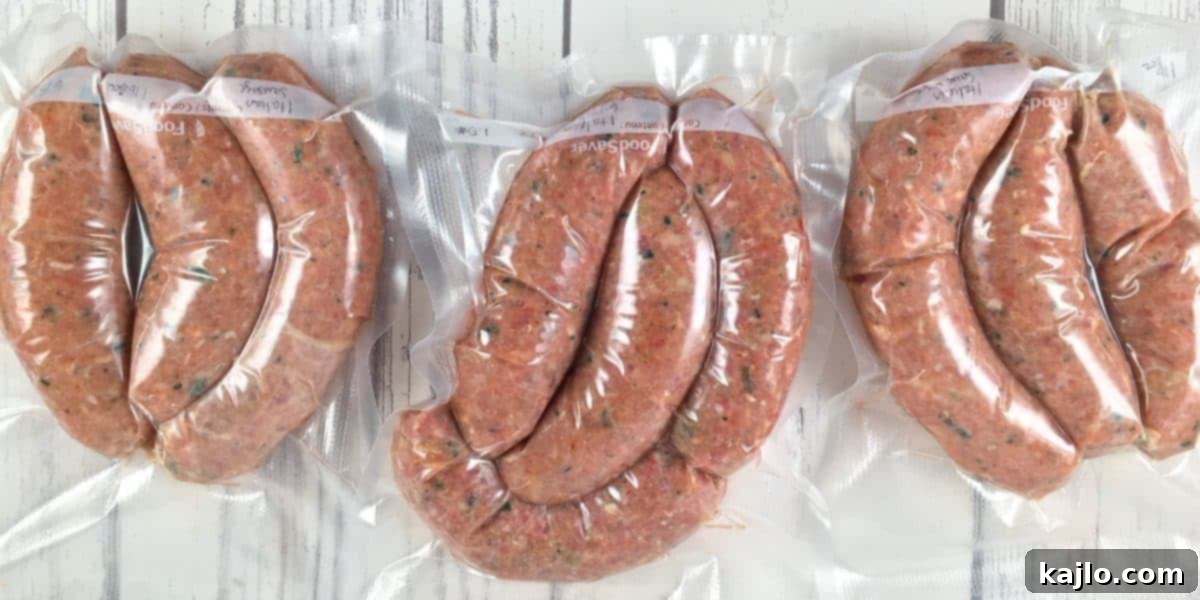
🐖** Inspiring Meals: Recipes with Homemade Pork Sausage Meat**
Now that you’ve mastered the art of making your own **sweet Italian sausage**, you might be wondering about the best **recipes to use homemade sweet Italian sausage**. The fantastic news is that there are countless **ways to use leftover Italian fennel sausage** to elevate your meals! Here are some of my top recommendations and favorite recipes that beautifully showcase the rich flavor of homemade pork sausage meat:
- **Low Calorie Lasagna (Lasagna with Zucchini):** A lighter take on a classic, where the savory sausage adds depth without excess calories, perfectly complemented by fresh zucchini.
- **Instant Pot Italian Sausage Soup:** A hearty, comforting soup that comes together quickly, with the fennel sausage infusing every spoonful with robust flavor.
- **Air Fryer Sausage and Peppers:** A quick and easy weeknight meal, delivering perfectly cooked sausage and tender-crisp peppers with minimal effort.
- **Crustless Keto Mini Quiche (Low Carb Keto Frittata):** Ideal for breakfast or brunch, these mini frittatas get a burst of flavor and protein from crumbled fennel sausage.
- **Air Fryer Sausage Stuffed Portobello Mushrooms:** Elegant yet simple, these stuffed mushrooms are a fantastic appetizer or light main, with the seasoned sausage filling standing out.
Beyond these specific recipes, Italian sausage is incredibly versatile. It’s a fantastic addition to classic pasta dishes, lending savory depth to marinara or creamy sauces. Incorporate it into hearty lentil and bean stews for a satisfying, protein-packed meal. Fennel sausage also makes an exceptional pizza topping, transforming a simple pie into a gourmet experience. For a comforting meal, serve it alongside creamy polenta or fluffy mashed potatoes, allowing the rich flavors to shine through. The possibilities are truly endless!
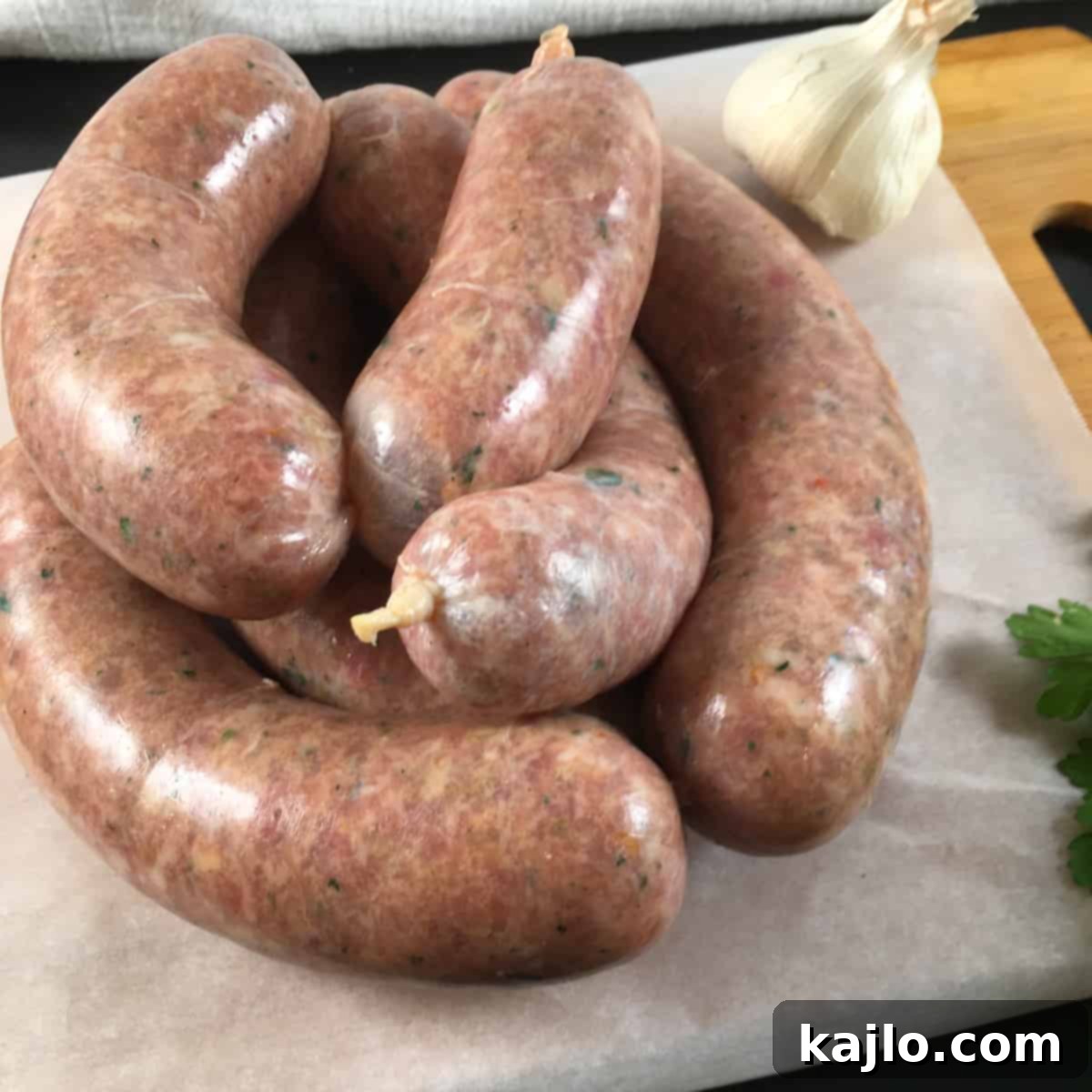
**📋 Nutrition Overview: Calories, Net Carbs, and Protein**
For those monitoring their dietary intake, it’s helpful to know the nutritional breakdown of these homemade Italian pork sausages. One serving of this recipe, standardized at 4 ounces (113 grams) of sausage, provides approximately 185 calories. It boasts a very low carbohydrate count, with only 0.7 grams of net carbs, making it an excellent choice for low-carb and ketogenic diets. Furthermore, each serving is a significant source of protein, delivering 17.7 grams, which contributes to satiety and muscle health. Please note that this nutrition information pertains specifically to the sausage filling and does not include the sausage casing.
**Frequently Asked Questions (FAQs) About Italian Fennel Sausage**
**Is fennel sausage inherently spicy?**
The spiciness of fennel Italian sausages can vary significantly. In U.S. markets, you’ll typically find varieties labeled as “hot” (spicy), “sweet,” or “mild” (not spicy). Spicy fennel sausage varieties commonly include a generous amount of red pepper flakes to impart heat. Sweet Italian sausage, on the other hand, usually features ingredients like sweet basil, offering a milder, more aromatic profile. While this particular recipe for homemade fennel sausage does incorporate some crushed red pepper flakes, it’s designed to be a balanced, sweet, and mild fennel sausage, allowing the fragrant fennel flavor to truly shine without overwhelming heat.
**Where can I purchase quality fennel sausage?**
Fresh fennel sausage is widely available in most major supermarkets and local butcher shops across the U.S., offering convenient access to this flavorful meat. For online purchasing options, you can often find raw Italian fennel sausage on platforms like Amazon. Additionally, for those seeking high-quality, fully cooked, and sugar-free options, U.S. Wellness Meats offers excellent pork Italian sausages, perfect for quick and healthy meals.
**Can fennel sausage be a vegetarian option?**
Traditionally, Italian fennel sausage recipes are made with ground pork or a blend of pork and other meats, meaning they are not suitable for vegetarian diets. However, with the growing popularity of plant-based alternatives, companies like Field Roast offer wheat gluten-based vegan fennel sausages. These products aim to replicate the texture and flavor profile of traditional sausage, providing an excellent plant-based option for those seeking a meat-free alternative.
**What distinct flavor does fennel sausage offer?**
The defining characteristic of fennel sausage is the unique flavor imparted by the fennel seeds. This creates an aromatic, anise-like taste that many describe as reminiscent of a mild version of black licorice. Interestingly, despite my personal strong dislike for black licorice, I absolutely adore the nuanced and savory flavor of fennel sausage. The anise notes are typically much more subtle and harmonious within the savory meat and spice blend, contributing a sophisticated and addictive quality that is widely appreciated in Italian cuisine.
**What is the origin behind the name “Italian sausage”?**
It comes as no surprise that the name “Italian sausage” derives directly from its origins in Italy! This beloved food staple has been a part of Italian culinary traditions for centuries. In Italy, sausages are broadly referred to as “salsiccia,” with numerous regional variations reflecting diverse local ingredients and seasoning preferences. The term “Italian sausage” in English-speaking countries typically refers to a specific style of sausage that has become popular and adapted from these rich Italian traditions.
**Can Italian sausage exist without fennel?**
While the term “Italian sausage” in the U.S. almost universally implies the inclusion of fennel, the culinary landscape of Italy tells a different story. In Italy, sausage seasonings are incredibly diverse, varying significantly from region to region. Consequently, authentic Italian sausages may or may not contain fennel. For example, Sicilian sausage frequently incorporates fennel seeds, contributing to its distinctive flavor. Conversely, a prominent example of an authentic Italian sausage from Italy that typically does not feature fennel is ‘luganega’ (also known as ‘luganica’), showcasing the wide range of traditional Italian flavors that exist beyond the fennel-centric varieties popular elsewhere.
👩🏻🍳** Expanding Your Skills: More Meat Grinder Recipes**
Once you’ve mastered this delicious homemade fennel Italian sausage, your meat grinder opens up a world of other exciting possibilities for custom sausage creations. If you’re looking for more innovative **sausage filling recipes** to try, explore these fantastic options:
- **Homemade Sausage with Chicken, Feta, and Sun-Dried Tomatoes:** This vibrant recipe creates a delightful and unique breakfast sausage, bursting with Mediterranean flavors and a satisfying texture.
- **Chicken Bratwurst with Pork:** A leaner yet incredibly flavorful take on the classic bratwurst, combining the best of both chicken and pork for a succulent sausage perfect for grilling or pan-frying.
- **Chorizo Recipe (Fresh, Homemade Mexican Chorizo Sausage!):** Dive into the bold, spicy flavors of authentic Mexican chorizo. This homemade version allows you to control the heat and spices for a truly personalized experience.
Each of these recipes showcases the versatility of your meat grinder and provides an opportunity to experiment with different flavor profiles, ensuring your freezer is always stocked with delicious, wholesome homemade sausages for any occasion.
Watch How to Make It!
An in-depth video tutorial on making this recipe is available! You can find the updated video here, offering far more detail than typical video snippets.

Homemade Italian Fennel Sausage Recipe (Meat Grinder)
Recipe by Summer Yule
Rated 5 out of 5 stars from 6 votes.
Pin Recipe
45 mins
45 mins
Slow Food DIY
Italian
17
185 kcal
Ingredients
- 2 lbs **pork butt or pork shoulder** (907 grams)
- 2 lbs **chicken thighs** (907 grams; boneless and skinless)
- 1 tablespoon **salt**
- 1 teaspoon **black pepper**
- 3 tablespoons **red wine vinegar**
- ¼ cup **fresh parsley, chopped**
- 6 cloves **garlic, minced**
- 2 teaspoons **onion powder**
- ½ tablespoon **dried basil**
- ½ tablespoon **dried oregano**
- 1½ tablespoons **fennel seeds, ground** (they can be crushed with a mortar and pestle)
- ½ teaspoon **crushed red pepper flakes**
- ½ teaspoon **dried sage**
- ½ teaspoon **sweet paprika**
- 1 package **hog casings**
Love this recipe?
Please leave a comment below 😊
Instructions
- Keep your ingredients at 38-40°F/3.3-4.4°C (almost frozen) for easier cutting and grinding. Cut the pork and chicken into 1-inch/2.54-cm cubes (or smaller).
- In a large bowl, place all ingredients except for the hog casings. Stir to combine. Refrigerate this mixture while you set up your meat grinder.
- Using a meat grinder, coarsely grind the mixture. Send the mixture through the grinder slowly, so that you do not create a jam.
- After sending all of the sausage mixture through the grinder once, grind it using the coarse grind plate a second time.
- You can shape the mixture into sausage patties at this point if you would like. If you would rather have links in casings, refrigerate the sausage mixture while you do the next steps.
- Clean your meat grinder thoroughly and set it up for stuffing sausage. I needed to use the largest stuffing funnel for the hog casings. Rubbing the outside of the stuffing funnel with a little oil can help the casing slide on easier.
- Remove your hog casings from their packaging and rinse them in cool water. Prepare them for filling as directed on the packaging. For the ones I am using, I had to soak them in cool water for 15 minutes and then untangle a few and cut them into 2-foot (0.6 m) lengths. Then I opened one end of each casing I was using and let cool water (from the faucet) run through the entire length. I let water run through each casing I was using three times, and I only rinsed the insides of the casings I was planning to use. After rinsing, I tied a knot in one end of each casing and set them near the grinder on a paper towel.
- When you are ready to stuff sausages, slide a casing over the end of the stuffing funnel. I was able to get the casing to fit by gathering it like I would gather pantyhose I was about to stick my toes into, and then sliding it onto the funnel. My grinder recommends leaving 2 inches (5 cm) of casing overhanging the end of the stuffing funnel, but the directions for your grinder may vary.
- Very slowly start sending your ground sausage mixture through your meat grinder. One hand can use the stomper to push the mixture into the grinder while your other hand can help guide the casing as it fills.
- After filling a casing, you can make small links by tying off the casing frequently with kitchen twine. Start tying at the closed end of the casing, making sure there is room for the filling to extend to the open end so the casing does not break. Tie off the open end of the casing last.
- After you finish filling one casing, tie a new casing onto the machine and continued the filling process. I did not clean out the machine each time I had finished filling a casing.
- Once all of the sausage mixture is used, turn off and unplug your meat grinder. I recommend cleaning out your grinder immediately. I was able to salvage an additional 9 ounces (255 g) of sausage mixture that was stuck to various parts inside the machine. You can press these leftovers into patties, pan fry them, and enjoy them right away. (Yay, snack time!)
- Your homemade sausages will not stay fresh as long as the cured sausage you buy in the store. Any sausages that you are not planning to cook within 24 hours should be double-wrapped in plastic and frozen. If you have a vacuum sealer for food, you can use that for your sausages as an alternative to double-wrapping.
- Follow the directions on your casing packaging to store the casings that you did not use. For the brand I purchased, I dried the unused casings (the ones where I did not rinse the interiors), repacked them in salt, and stored them in the fridge where they will wait until my next sausage-making adventure.
- Note: Don’t miss the updated Italian Fennel Sausage recipe video here! It is far more detailed than the video below!
Equipment
- Meat Grinder
- Kitchen Twine
- Vacuum Sealer
Notes
**💭 Expert Tips from Dietitian Summer Yule**
This is a level 2 recipe (transition or weight maintenance). Is fennel sausage healthy? These mild fennel sausages are a fresh, seasoned meat adapted from Mediterranean cuisine. I consider them another tasty and nutrient-rich addition to a health-promoting diet of whole foods.
This recipe makes approximately 4 pounds, 4.5 ounces (1.9 kg) of Italian fennel sausage. That means you get about 17 4-ounce (113 g) servings. Sausage generally isn’t a lean protein option. However, using chicken in place of some of the fatty pork shoulder here makes this a lighter sausage than most.
Keeping some of the pork means that you should not need to add oil later when you cook the sausage. Additionally, your family may not even be able to tell that there is some chicken in there!
People generally don’t eat Italian sausages by themselves. How low calorie or high calorie your sausage meal will be ultimately depends on what else you’re eating! Here are a few (likely) low calorie ways to enjoy pork fennel sausage:
- As part of a broth-based soup
- Cooked, sliced, and used on a salad with low-calorie dressing
- As sausage and peppers served over spaghetti squash or zoodles
And here are a few (likely) high calorie ways to enjoy pork fennel sausage:
- As part of a cream or cheese-based soup
- With a big plate of pasta and tomato sauce
- As sausage and peppers served in hoagie rolls
All the options sound so good, don’t they? Buon appetito!
Nutrition information is for one serving. Nutrition information is for a 4-ounce (113 gram) serving of the sausage and does not include the sausage casing.
nutrition info disclaimer
All recipes on this website may or may not be appropriate for you, depending on your medical needs and personal preferences. Consult with a registered dietitian or your physician if you need help determining the dietary pattern that may be best for you.
The nutrition information is an estimate provided as a courtesy. It will differ depending on the specific brands and ingredients that you use. Calorie information on food labels may be inaccurate, so please don’t sweat the numbers too much.
“To taste” means to your preferences, which may have to be visual to follow food safety rules. Please don’t eat undercooked food x
Nutrition
Calories:
185
kcal
Carbohydrates:
1.1
g
Protein:
17.7
g
Fat:
12.8
g
Saturated Fat:
4.7
g
Sodium:
575.9
mg
Fiber:
0.4
g
Vitamin A:
2.3
% DV
Vitamin C:
2.4
% DV
Calcium:
1.7
% DV
Iron:
5.3
% DV
fennel sausage, Italian fennel sausage, Italian fennel sausage recipe, Italian sausage, Italian sausage recipe, make fennel sausage, make Italian fennel sausage, meat grinder, mild Italian sausage, sweet Italian sausage
Shop our cookbook!
Easy Air Fryer Recipes for One
Burning your air fryer recipes?
Here’s how to fix it!
Join our community! Subscribe for all of the latest and greatest recipes, and follow me on Facebook, Pinterest, Instagram, and YouTube!
